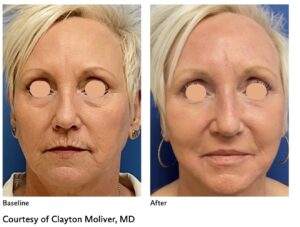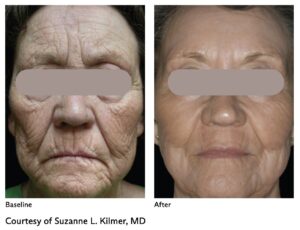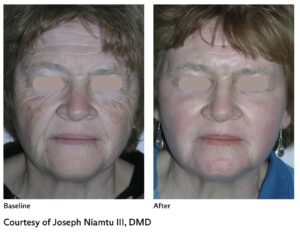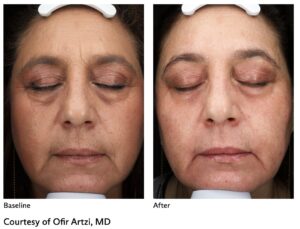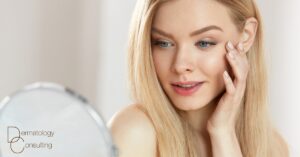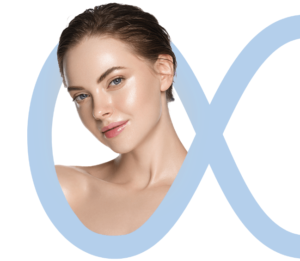CO2 UltraPulse® Laser
CO2 UltraPulse® Alpha Laser by Lumenis for Fully Ablative Resurfacing and Fractional Laser Resurfacing
Dermatology Consulting is delighted to be one of the first and few clinics in the United Kingdom to have the latest and most powerful version of the UltraPulse® Alpha by Lumenis.
CO2 (Carbon Dioxide) fully ablative resurfacing still remains the gold standard for full skin resurfacing, and the UltraPulse® by Lumenis is widely regarded by laser experts throughout the world as the “Ferrari” of CO2 lasers. The Alpha is the latest and most advanced version.
Explore Topics On This Page
- What are the Advantages of the CO2 UltraPulse® Alpha?
- Fully Ablative CO2 Laser Resurfacing
- What Does Fully Ablative CO2 Laser Resurfacing on the Face Involve?
- What Does the CO2 Laser Resurfacing Healing Process Involve?
- What Does Fractionated Ablative CO2 Laser Resurfacing Involve?
- What about Treatment of Scars with the UltraPulse® Alpha?
- Is the UltraPulse® Alpha Suitable for All Skin Types?
- How Do I Arrange Treatment with the UltraPulse® Alpha CO2 Laser?
What are the Advantages of the CO2 UltraPulse® Alpha?
The development of the original “UltraPulse®” CO2 technology was a big step forward in laser resurfacing as it has the fastest pulse duration compared to competitors which means that it heats the targeted skin very quickly to achieve the desired effect but does not overheat the surrounding skin. This means that it causes less unnecessary heating of surrounding skin and therefore is less painful and causes less swelling and redness than other CO2 laser manufacturers. This gives a faster recovery time for the patient.
It is very adaptable and can be used to give 100% coverage to fully remove the entire surface area (described as fully ablative) either extremely superficially or deeply, but it can also be used to treat a fraction of the target area (described as fractionated). It can be used extremely superficially, but the fractionated settings can also be used up to 4mm which is the deepest of all CO2 lasers on the market which allows it to treat very thick scars. It can also be used in combination in the same treatment setting i.e. fully ablative plus fractionated which gives the benefit of both.
The settings can be very quickly and easily changed. This means that the treatment can be fine tuned to the individual patient’s need, for example the deep “bar code lines” on the upper lip often need deeper and 100% coverage to flatten them down, whereas the thinner, less wrinkled skin on the outer cheeks or the delicate skin of the neck usually only needs more superficial fractionated settings. The more coverage and the deeper the setting, the longer the recovery time, but the UltraPulse® Alpha laser allows us to tailor-make a bespoke treatment according to what results and recovery time are desired. Often we will use very different settings on different parts of the face during the same session.
Fully Ablative CO2 Laser Resurfacing
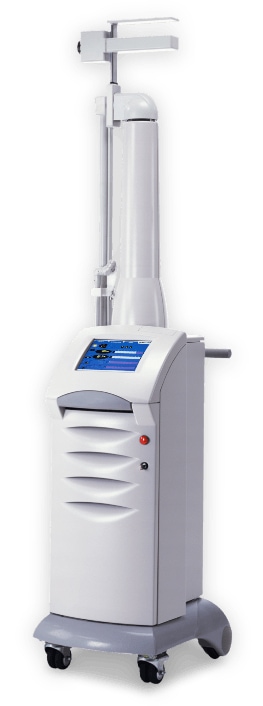 Fully ablative CO2 Resurfacing is when the laser is used to give 100% coverage and it is still regarded as the gold standard to improve lines and wrinkles permanently. It can also permanently remove brown spots/ ”sun spots” (the medical name “solar lentigos”) and “age spots” (medical name “seborrhoeic keratoses”). The versatile UltraPulse® Alpha can be adjusted between very superficial settings for thin skin or deeper settings for thicker skin and deeper wrinkles.
Fully ablative CO2 Resurfacing is when the laser is used to give 100% coverage and it is still regarded as the gold standard to improve lines and wrinkles permanently. It can also permanently remove brown spots/ ”sun spots” (the medical name “solar lentigos”) and “age spots” (medical name “seborrhoeic keratoses”). The versatile UltraPulse® Alpha can be adjusted between very superficial settings for thin skin or deeper settings for thicker skin and deeper wrinkles.
In addition, the heat of the CO2 laser causes some immediate tightening of the skin which can be seen as the treatment takes place. The tightening continues over several weeks as the healing progresses and visible improvement continues for up to a year after the treatment.
Fully ablative resurfacing usually requires the patient to take a week at home to recover, but if done at strong settings it can result in the skin looking 5-10 years younger permanently.
What Does Fully Ablative CO2 Laser Resurfacing on the Face Involve?
If the treatment is being performed on the face, you usually take anti-viral and antibiotic medication starting the day before to reduce the chance of viral or bacterial infection developing in the healing skin.
On the day of the treatment, photographs are taken and the skin cleaned thoroughly. Strong numbing cream is applied for 60 minutes and pain killing tablets (and sometimes a painkilling injection) are given. During this time, we show you how to care for your skin afterwards.
After the numbing cream has been on for one hour, you move to the treatment room where the numbing cream is removed and the skin cleaned with antiseptic cleanser. Depending on the treatment planned, local anaesthetic injections may be given to give additional numbing to certain areas. If the eyelids are being treated, gentle local anaesthetic drops are placed in the eyes and special metal contact lenses with soft lubricating gel are gently placed in the eyes to protect them. After the eyelids are treated these contact lenses are easily removed and the eyes are then covered with external protective goggles.
The rest of the face is treated – usually as one pass, but in the case of severe wrinkles, additional passes may be used. The UltraPulse® Alpha is very quick and it usually takes 30 minutes to treat a full face and 15 minutes for the neck.
Afterwards the skin is soothed with saline gauze and then gauze soaked in a gentle antiseptic cleanser or dilute vinegar (which is a very effective natural anti-infection agent). A gentle pure healing ointment is applied afterwards. We also apply an infrared LED light therapy to speed up healing. If one wishes, as an additional step, platelet rich plasma (PRP) could be prepared from your own blood and massaged into the lasered area immediately after treatment as there are some suggestions that your own natural growth factors produced by the PRP may speed up healing and possibly improve results.
We instruct you how to do the antiseptic or vinegar soaks followed by the healing ointment regularly for 4-6 days. It is very important to do the antiseptic or vinegar soaks regularly and to continue with the anti-viral and antibiotic medication for the week after the treatment to avoid infection getting into the new healing skin.
We will see you again the next day for additional LED light therapy and are in contact with you over the week as you continue to heal.
“I recently received a CO2 facial resurfacing from Dr Anne Farrell, who is an absolutely incredible Dermatologist. Dr Farrell prepared me extremely well prior to treatment and had gathered all the necessary information to ensure I was at ease throughout the entire process. The entire procedure was painless and I was extremely relaxed throughout.”
What Does the CO2 Laser Resurfacing Healing Process Involve?
The stronger the settings, the redder the skin is afterwards. There may be some slight pinpoint bleeding but this usually settles by the next day. However, for a typical treatment the skin is very red, crusted and swollen for 5-6 days and starts to peel around the 6th day. Most patients will not be able to go out of the house or have social engagements during this time, but on the 7th day most patients are able to apply make-up to the treated area and go out.
The skin continues to be pink for several weeks afterwards (or in the case of darker skin it will usually become temporarily dark for several weeks) but this is a sign of continued improvement occurring. If the pinkness is very troublesome, it can be faded with anti-redness (vascular) lasers and if the pigmentation is troublesome, it can be faded with creams.
What Does Fractionated Ablative CO2 Laser Resurfacing Involve?
Fractionated ablative CO2 laser resurfacing (i.e. when small islands of the skin are treated leaving normal skin in between to speed up healing) when done on the face usually involves the same procedure as fully ablative resurfacing, but the healing process will be quicker. Nevertheless you will still need to be at home for 4-7 days, depending on the setting used.
When treating the neck, chest, hands or other body sites, fractionated treatments are used as these areas do not have the ability to regenerate as well or quickly as the face. Lower settings are also usually used so healing is quicker, although redness or post inflammatory hyperpigmentation may last longer than on the face.
On the face fully ablative resurfacing and fractionated treatments can be combined in the same session to the maximise results.
What about Treatment of Scars with the UltraPulse® Alpha?
The UltraPulse® Alpha is widely thought by most international laser experts to be the most advanced and powerful laser to treat scars. It is highly versatile and quick. When treating scars, it has now been established that low density is better and safer, and the very versatile UltraPulse® Alpha allows this.
Another advantage is that the holes that are created in the scar by the fractionated CO2 treatment is a perfect way of introducing additional treatments to add to the improvement e.g. steroid or 5-Flourouracil to soften and flatten the scar, Bimatoprost® to re-pigment the scar, or Sculptra® to thicken a depressed scar.
Depending on the scar, additional treatments can be performed before the UltraPulse® Alpha to address other problems in the scar e.g. redness can be improved by the pulsed dye laser or KTP laser and pigmentation can be reduced by the Fraxel 1927nm laser or Picoway laser.
Every scar is different and needs a different treatment plan and the super advanced and versatile UltraPulse® Alpha allows us to tailor-make a bespoke treatment package for each individual scar.
Is the UltraPulse® Alpha Suitable for All Skin Types?
After the procedure the skin is very pink for a couple of weeks, and in the case of individuals with fair skin, when strong settings are used, the skin can remain pink for a couple of months. The ongoing pinkness, however, is a sign that the skin is continuing to remodel and improve following the treatment. If desired the pinkness can be improved more quickly with one of our vascular lasers e.g. lasergenesis or Intense Pulsed Light.
In the case of patients with darker skin (e.g. Mediterranean or Asian skin types) rather than become pink for several weeks the skin will become darker (called post inflammatory hyper pigmentation), and this is worsened if there is sun exposure on the skin. The darker the skin, the worse the post inflammatory hyperpigmentation is likely to be. However, this hyperpigmentation can be treated with prescription creams and most individuals with very dark skin tend not to have such severe wrinkles as those with fair skin, so fortunately do not usually need such strong settings as those with fair skin.
How Do I Arrange Treatment with the UltraPulse® Alpha CO2 Laser?
The impressive UltraPulse® Alpha is only performed by the consultant dermatologist. If you are interested in improving the appearance of your skin significantly with a single treatment and are prepared to have a few days out of socialising while the skin recovers, contact us to arrange a consultation to discuss how the UltraPulse® Alpha can benefit your skin.
